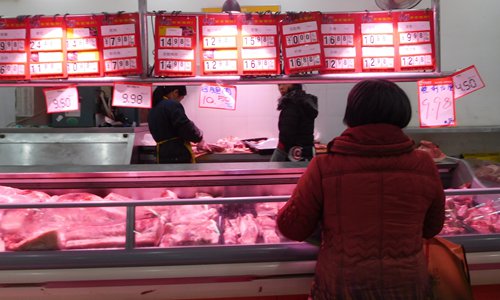HOME >> BUSINESS
China takes steps to contain ASF outbreaks as pork prices surge
Source:Global Times Published: 2019/7/3 21:43:40
Nation takes steps to contain ASF outbreaks as pork prices surge

A consumer buys pork at a local market in Yunyang, Southwest China's Chongqing in February. Photo: IC
China on Wednesday released new guidelines to contain the outbreaks of African swine fever (ASF) in the country, as pork prices have been surging due to a fall in supplies because of the disease.
Though China has made progress in stopping the spread of the ASF over the past year, there are still loopholes and inefficiency and the situation is still complex and serious, said the guidelines released by the State Council, China's cabinet.
Specific measures outlined in the guidelines involve supervision of epidemic prevention, transportation, production, waste management, entry quarantine and financial support from authorities to hog producers.
To prevent and control the menace of ASF, China will strengthen the information-sharing mechanism among government agencies and improve supervision by means of the internet and big data, according to the guidelines.
China's first outbreak of ASF was discovered in August 2018, and there have been 143 outbreaks in 30 provinces and regions as of Sunday, said Yu Xinrong, vice minister of the Ministry of Agriculture and Rural Affairs (MARA), during a press conference on Monday. Yu added that affected regions involved in 131 cases and 25 provincial-level areas had been removed from a quarantine list.
That led to a drop in domestic supplies of pork and pushed up pork prices, analysts said.
The average wholesale price of pork was 22.54 yuan ($3.28) per kilogram on Monday, up 10.2 percent from June 1, according to monitoring data released by the MARA.
The rise in pork prices has contributed to lifting China's consumer inflation because it has a large weighting in the basket of food prices monitored, according to Ma Wenfeng, a Beijing-based agricultural analysts.
The consumer price index (CPI) rose to a 15-month high of 2.7 percent in May. Chinese policymakers are trying to keep the CPI in a reasonable range to allow scope for monetary tools to battle downward economic pressure.
The drop in supply also contributed to an increase in imports. China imported 658,000 tons of frozen pork as of May, up 20 percent year-on-year. Imports are expected to reach 1.7 million metric tons this year, while production is expected to decrease by 6.7 percent, according to the China Agricultural Outlook Conference (2019- 28).
But "import growth is not enough to make up the gap between supply and demand," Ma told the Global Times on Wednesday.
Newspaper headline: Nation takes steps to contain ASF outbreaks as pork prices surge
Posted in: INDUSTRIES